Poland Prefabricated Buildings Market Size
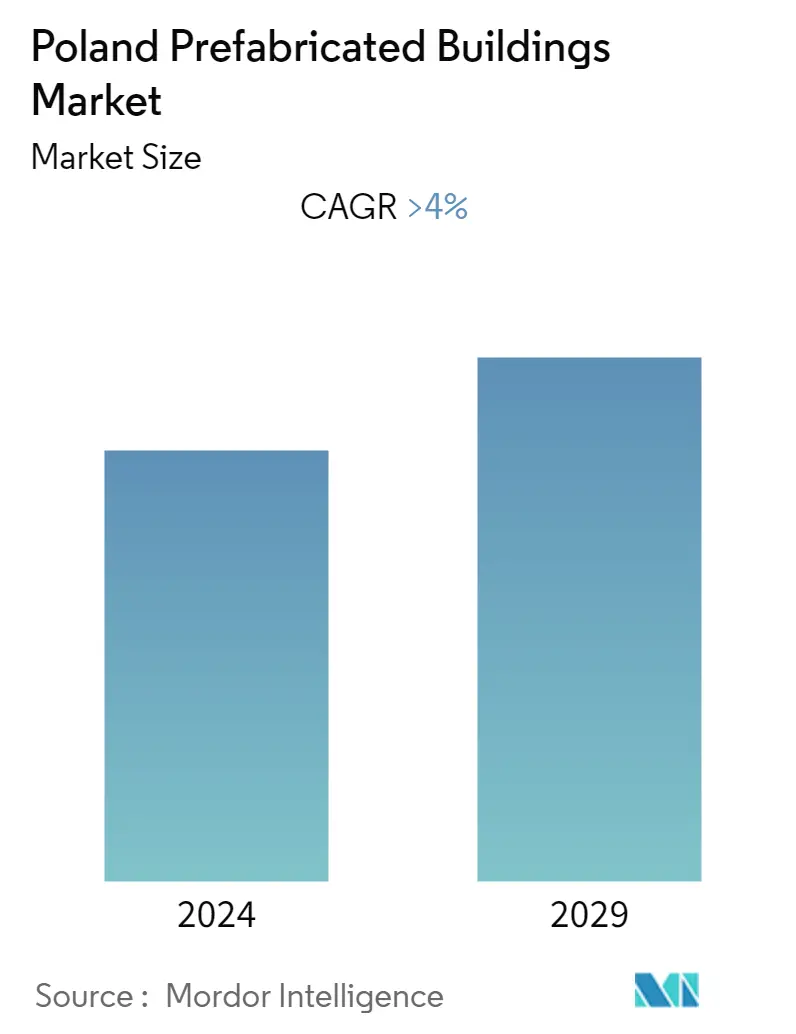
| Study Period | 2019 - 2029 |
| Base Year For Estimation | 2023 |
| Forecast Data Period | 2024 - 2029 |
| Historical Data Period | 2019 - 2022 |
| CAGR | 4.00 % |
| Market Concentration | Medium |
Major Players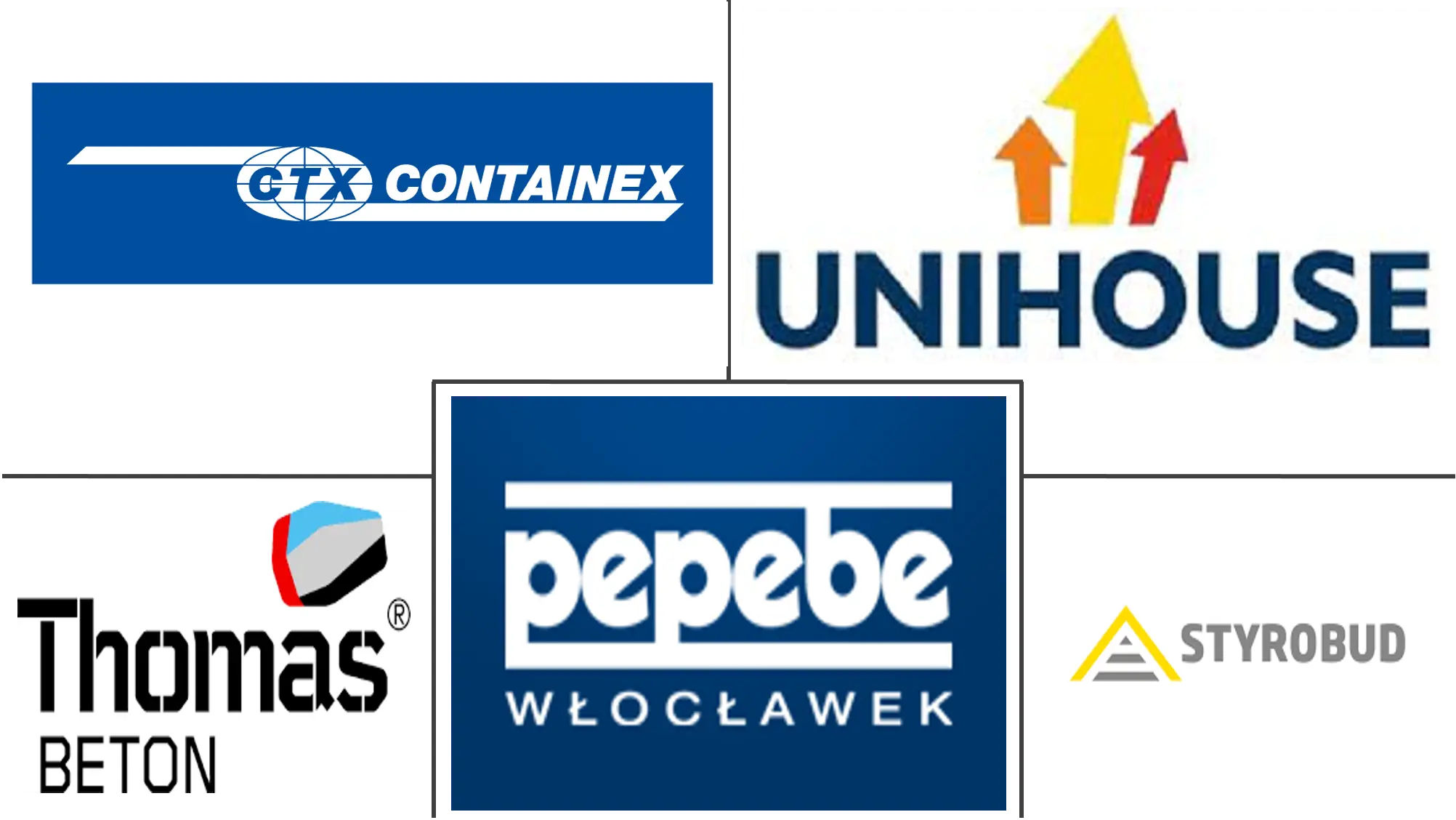
*Disclaimer: Major Players sorted in no particular order |
Poland Prefabricated Buildings Market Analysis
During the forecast period, the Polish prefabricated building industry is expected to grow at a rate of more than 4% per year.
- When the COVID-19 pandemic broke out, it caused a lot of uncertainty for vendors and contractors in Poland's construction business.Several construction companies shut down their projects due to lockdowns and restrictions. However, due to immediate requirements for hospitals and quarantine sectors, the demand for prefabricated materials increased. As a large workforce is required for traditional construction, prefabricated buildings are an optimum solution during the pandemic. With the increasing shift toward turnkey housing solutions, the prefabricated housing market expects to pick up across Poland. Moreover, the ease of preparation and consent procedures are likely to boost the demand for prefabricated houses.
- The future of prefabricated construction looks stable, and the demand for modular systems is likely to grow. This is because people want to live in homes that are affordable, comfortable, and good for the environment.As the focus on turnkey solutions increases, prefabrication is witnessing steady growth in Poland. The increasing government spending on sustainable infrastructure development through continuous investment in energy-saving and environmentally sustainable assets boosts market demand for Polish construction and infrastructure companies.
- In developing economies where industrialization, urbanization, and fast population growth are happening, the prefabricated building market is expected to grow over the next few years. The prefabrication process of the building changed the entire construction industry. It is more efficient and can be completed 30-50% faster than traditional construction methods. Additionally, prefabricated construction will have ample opportunities to grow due to rising consumer preferences for green buildings and sustainable construction processes.
Poland Prefabricated Buildings Market Trends
The Rising Demand for Prefabricated Houses in Poland is Notably Driving Market Growth
People in Poland are likely to want more convenience and security (like a guarantee) in their homes, which will drive the need for prefabricated buildings.Using prefabricated buildings can speed up construction on-site, reduce the effects of things that can't be controlled, improve quality and consistency, save money, be reused, waste less raw materials, and reduce safety risks.
Increasing demand for energy-efficient houses is an emerging trend in the market. Houses account for almost 40% of the world's energy consumption, so the energy production required for buildings is capital-intensive. Modular houses are energy efficient. As a result, the demand for airtight houses has increased significantly because they are highly insulated and energy efficient, so they can produce as much renewable energy as possible. These houses are equipped with ground-source heat pumps (GSHP) and photovoltaic (PV) systems and also have a passive solar structure in the panel housing. In addition, prefabricated contractors and architects design these house models that include features such as solar panels, wind turbines, and even rainwater systems. As a result, such factors are expected to drive the growth of Poland's prefabricated building industry during the forecast period.
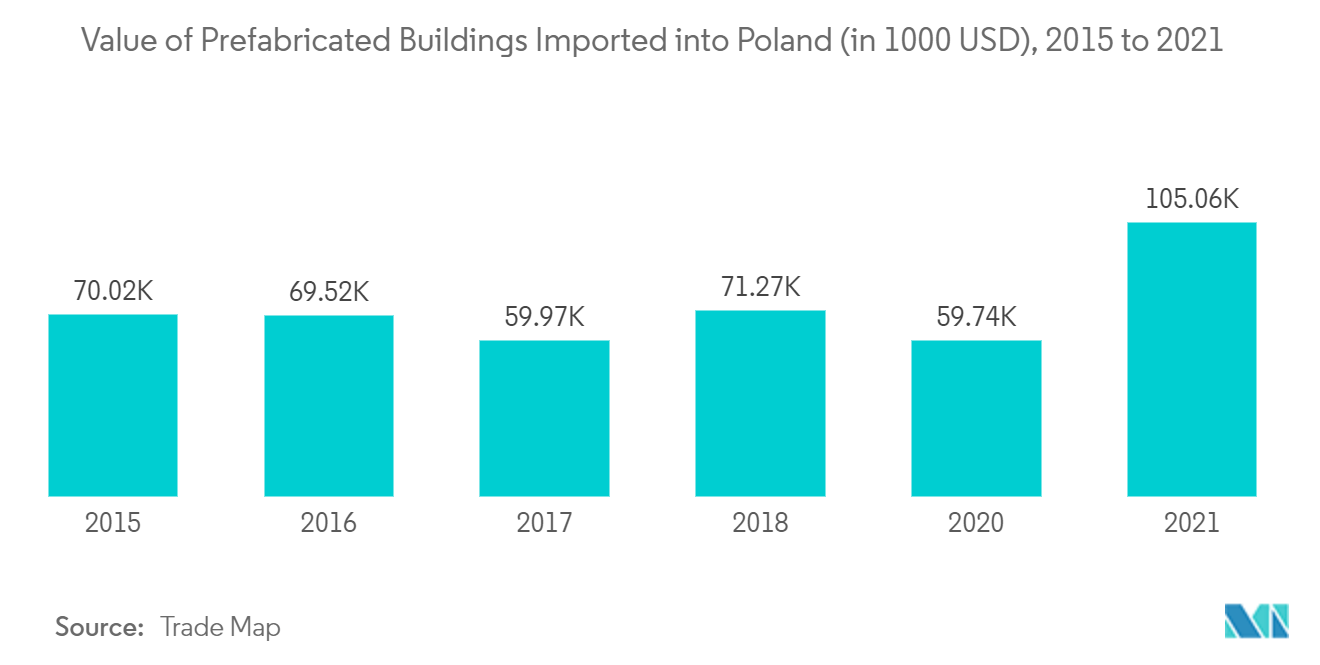
Rapid Urbanization Boosts the Demand for Prefabricated Buildings in Poland
Due to population growth and a lack of housing, modular construction is becoming more popular in Poland.It is gaining momentum as an effective means to build affordable housing. A record amount of new housing was delivered for use in Poland in 2021, according to Statistics Poland (GUS), a state agency. The 235,000 new houses and apartments marked the highest figure in four decades as well as a record in terms of floor space. Modular construction is becoming popular in Poland. The rise in building material prices, urbanization, and labor shortages in Poland are the main causes of this popularity.
More money is being put into modular construction in Poland, which is also helping the prefab industry grow. Nordhus specializes in the modular construction of multi-story buildings. Each year, the company's huge 35,000 m2 site and 10,000 m2 of production space are used to make about 1,000 prefabricated construction modules.According to data, the Polish government plans to build 20,500 houses, and prefabrication is expected to play a significant role there.
In Poland, there is a lot of growth in the residential sector of the prefabricated building market. Along with the general boom in residential construction in the country, the share of prefabricated housing solutions in residential construction is increasing and now stands at more than 20%, according to industry experts. Prices are also going up, and the market is growing because there is a lot of demand for turnkey or prefabricated homes and buildings that use less energy.
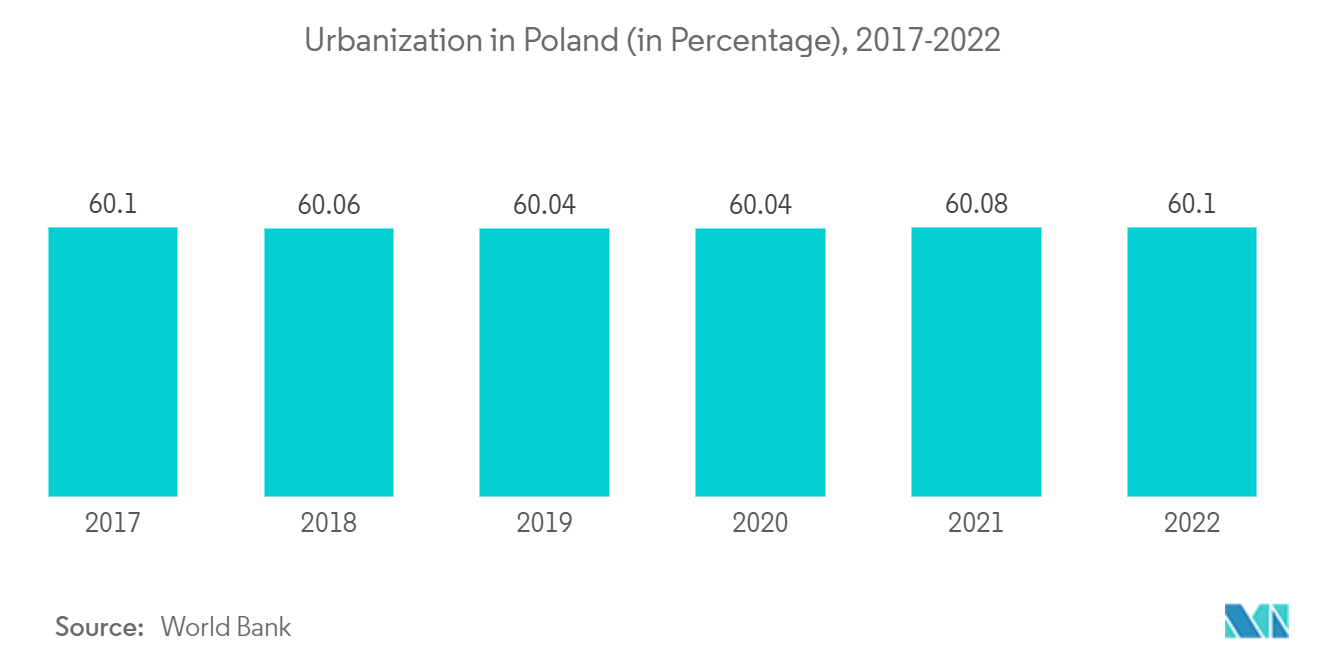
Poland Prefabricated Buildings Industry Overview
The market is highly fragmented in nature, with large companies claiming significant market share. Companies are focusing on technological innovations. Some suppliers are providing fully customized, prefabricated wooden structures. High capital requirements and rapid technological advancement are important barriers to entry for new participants. Intensified competition led to the emergence of many innovative and advanced solutions on the market, such as turnkey solutions and lightweight ceramic houses.
Because of this, it's important for businesses to be able to keep going, grow into other areas, and get domestic demand back up. Companies can use effective production technologies to keep product costs low and reduce risks, which helps them make more money. Containex, Unihouse, Thomas Beton, Styrobud, and Pepebe are the biggest companies in Poland's prefabricated building industry.
Poland Prefabricated Buildings Market Leaders
-
Containex
-
Unihouse
-
Thomas Beton
-
Styrobud
-
Pepebe
*Disclaimer: Major Players sorted in no particular order
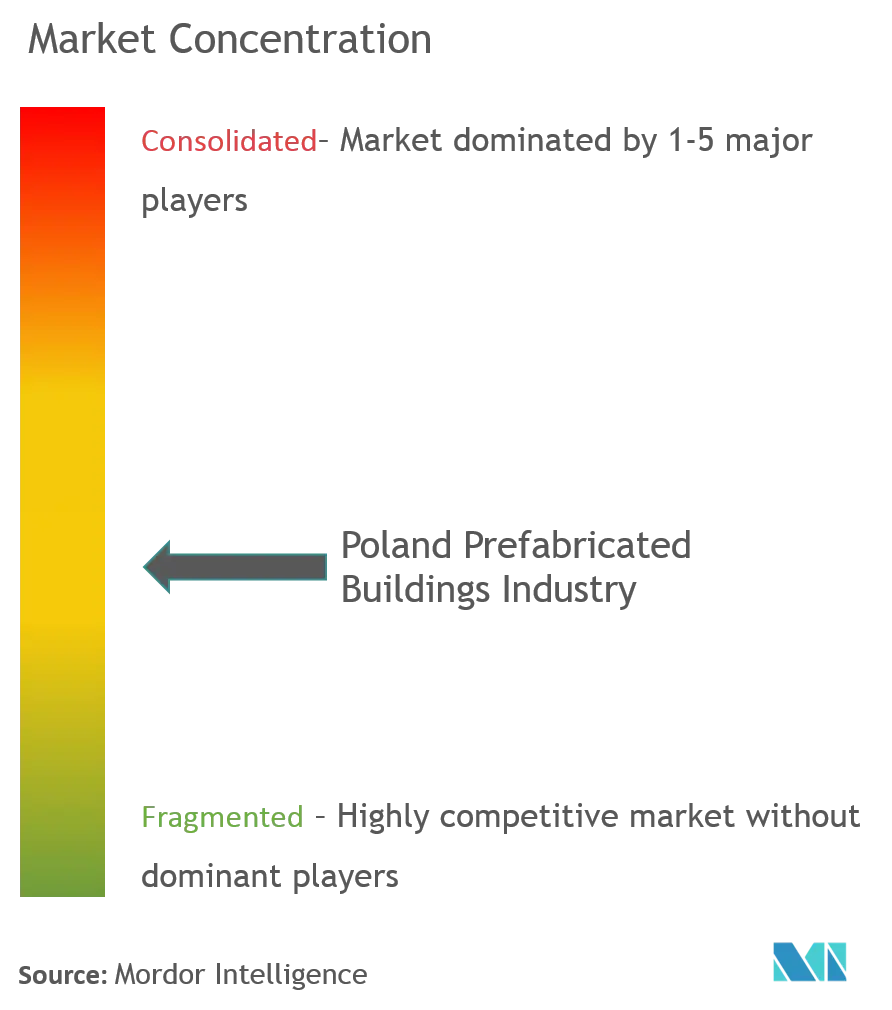
Poland Prefabricated Buildings Market News
- March 2023: European Company iQ Module Bets The Future on Shared Tech, Tools, and Partnerships. iQ Module-based out of Gdansk, Poland-has grown exponentially as a company, with offices in Germany and Denmark. The company has also embarked on an ongoing joint venture and partnership with Roger Krulak of FullStack Modular for projects in the U.S. and around the globe.
- March 2023: HOLCIM have acquired HM Factory, a provider of precast concrete solutions with net sales of CHF18 million. Offering solutions that cover a wide variety of needs, such as walls, staircases and balconies. HM Factory are well positioned to capitalize on growth in industrial and residential construction. The company supplies Polish construction projects as well as exporting to Scandinavian markets.
Poland Prefabricated Buildings Market Report - Table of Contents
1. INTRODUCTION
- 1.1 Study Assumptions and Market Definition
- 1.2 Scope of the Study
2. RESEARCH METHODOLOGY
- 2.1 Research Framework
- 2.2 Secondary Research
- 2.3 Primary Research
- 2.4 Data Triangulation and Insight Generation
- 2.5 Project Process And Structure
- 2.6 Engagement Frameworks
3. EXECUTIVE SUMMARY
4. MARKET INSIGHTS
- 4.1 Current Market Scenario
- 4.2 Technological Trends
- 4.3 Insights into Supply Chain/Value Chain Analysis of the Prefabricated Buildings Industry
- 4.4 Brief on Different Structures Used in the Prefabricated Buildings Industry
- 4.5 Cost Structure Analysis of the Prefabricated Buildings Industry
- 4.6 Impact of COVID-19 on the Market
5. MARKET DYNAMICS
- 5.1 Market Drivers
- 5.2 Market Restraints/Challenges
- 5.3 Market Opportunities
-
5.4 Industry Attractiveness - Porter's Five Forces Analysis
- 5.4.1 Threat of New Entrants
- 5.4.2 Bargaining Power of Buyers/Consumers
- 5.4.3 Bargaining Power of Suppliers
- 5.4.4 Threat of Substitute Products
- 5.4.5 Intensity of Competitive Rivalry
6. MARKET SEGMENTATION
-
6.1 By Material Type
- 6.1.1 Concrete
- 6.1.2 Glass
- 6.1.3 Metal
- 6.1.4 Timber
- 6.1.5 Other Material Types
-
6.2 By Application
- 6.2.1 Residential
- 6.2.2 Commercial
- 6.2.3 Other Applications (Industrial, Institutional, and Infrastructure)
7. COMPETITIVE LANDSCAPE
- 7.1 Market Overview(Market Concentration and Major Players)
-
7.2 Company Profiles
- 7.2.1 Containex
- 7.2.2 Unihouse
- 7.2.3 Thomas Beton
- 7.2.4 Styrobud
- 7.2.5 Pepebe
- 7.2.6 MCM Project
- 7.2.7 Budizol
- 7.2.8 Prologis
- 7.2.9 Unimex
- 7.2.10 Mabudo*
- *List Not Exhaustive
8. MARKET OPPORTUNITIES AND FUTURE TRENDS
9. APPENDIX
- 9.1 Marcroeconomic Indicators (GDP Breakdown by Sector, Contribution of Construction to Economy, etc.)
- 9.2 Key Production, Consumption, and Exports and Import Statistics of Construction Materials
Poland Prefabricated Buildings Industry Segmentation
Prefabricated buildings (also known as prefabs) are building structures manufactured offsite and transported to the on-site assembly location. It is made up of parts or units that are made in a factory and then shipped to the building site to be put together.
Poland's Prefabricated Buildings Industry is Segmented by Material Type (Concrete, Glass, Metal, Timber, and Other Material Types) and by Application (Residential, Commercial, and Industrial). The report offers market sizes and forecasts (USD) for all the above segments.
| By Material Type | Concrete |
| Glass | |
| Metal | |
| Timber | |
| Other Material Types | |
| By Application | Residential |
| Commercial | |
| Other Applications (Industrial, Institutional, and Infrastructure) |
Poland Prefabricated Buildings Market Research FAQs
What is the current Poland Prefabricated Buildings Market size?
The Poland Prefabricated Buildings Market is projected to register a CAGR of greater than 4% during the forecast period (2024-2029)
Who are the key players in Poland Prefabricated Buildings Market?
Containex, Unihouse, Thomas Beton, Styrobud and Pepebe are the major companies operating in the Poland Prefabricated Buildings Market.
What years does this Poland Prefabricated Buildings Market cover?
The report covers the Poland Prefabricated Buildings Market historical market size for years: 2019, 2020, 2021, 2022 and 2023. The report also forecasts the Poland Prefabricated Buildings Market size for years: 2024, 2025, 2026, 2027, 2028 and 2029.
Poland Prefabricated Buildings Industry Report
Statistics for the 2024 Poland Prefabricated Buildings market share, size and revenue growth rate, created by Mordor Intelligence™ Industry Reports. Poland Prefabricated Buildings analysis includes a market forecast outlook 2029 and historical overview. Get a sample of this industry analysis as a free report PDF download.



